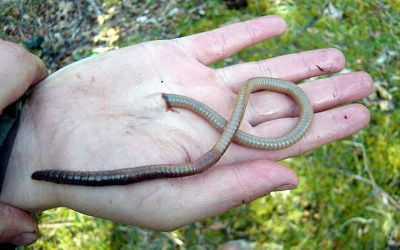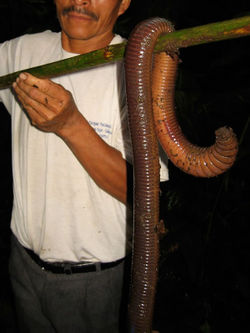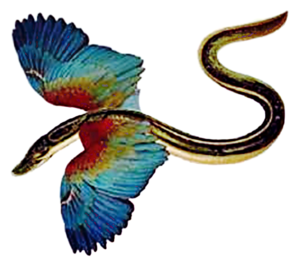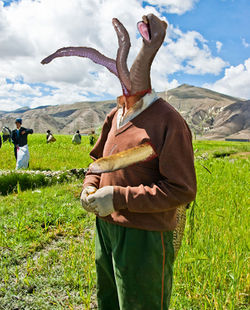Wyrm
Family lumbagus, genus lumbago.
Among the most common and important occupants of Planet Eyrth are the Wyrms. They were here before humans, and they will no doubt be here long after humans are gone. Furthermore their culture, though secretive, is every bit as complex and varied as human so-called culture. It's also worth noting that though you may find wyrms less than appealing, many wyrms think you are just the cat's pyjamas, and would, in fact, find you quite tasty.
The common belief that, since 'wyrm' is often regarded as the old word for 'worm', all wyrms must themselves be old has not been born out by the results of recent studies. In particular, careful analysis has shown that many earthwyrms are, in fact, quite young, having hatched from egg form within the last several decades. But we will have more to say about that later.
Sorts of wyrms[edit | edit source]
Earthwyrms[edit | edit source]
The common earthwyrm (scientific name lumbago lumbago) is perhaps the most well known member of the wyrms but hardly the most typical.
Among the more unusual features of earthwyrms is their neoteny (which my spell checker has never heard of -- what an ignoramus). In fact nearly all the earthwyrms you are ever likely to meet remain in their larval form. Even the largest of the South American varieties, lumbago giganticus, are hardly more than infants when compared with a full grown specimen. The fact that wyrms are so tasty has something to do with this, of course, as most of them will have been converted into some other animal entirely (by the process of digestion) long before they achieve their full potential.
Something to keep in mind, particularly when in regions where you might come in contact with dirt, is to always wear gloves. If you should find yourself "bitten" (as it is called by wyrm specialists) by an earthwyrm, call 911 immediately. If you are so unlucky as to have the paramedics decide that amputation is called for, remember: There are things that may be worse than losing a hand (or arm or leg or head or other body part).
Adolescent wyrms[edit | edit source]
Next time you see a "large" earthwyrm, remember: The ones you find in your garden are almost always the young ones. That's why they're all so small.
As wyrms mature, they also migrate.
Migration paths for wyrms vary, but their common feature is depth. In fact, petroleum workers frequently encounter adolescent wyrms, as a result of the depths to which they are required to drill. (This is one of the reasons oilfield workers are paid as well as they are -- if they weren't, there's no way they'd risk the likelihood of having to deal with these monsters.) To the right, we see an image of a drill operator who has encountered an adolescent wyrm caught in the "updraft" of the drill bit.
Flying wyrms (Lumbago Flederaalus)[edit | edit source]
In South America, though full-grown earthwyrms are rare (and wyrms of all sorts are generally small and well behaved), it is none the less not uncommon to encounter flying wyrms (Lumbago Flederaalus).
Distant cousins of the high-flying Queen Snakes of northwestern Australia, flying wyrms are commonly found in rainforests, where their colorful feathers blend in with the plumage displayed by the birds. In fact, for many years scientists were convinced that these wyrms were nothing more than mute birds, and descriptions of sightings by locals living in the jungles were dismissed as hallucinations brought on by the practice (common in such areas) of eating crops grown in unsterilized dirt.
However, historical evidence, notably in the form of hand-colored drawings by pre-scientific biologists who had not actually visited any of the places where flying wyrms are naturally found, but were just working from descriptions brought back by sailors who had visited such lands, eventually convinced the scientists of Europe to mount an expedition. The eventual retrieval of an extremely elongated skeleton with what appeared to be flaps attached to it provided the final proof of the existence of the Flederaalus species.
It is widely hoped that the Bullfinch expedition of 1993 may eventually return and provide us with a second skeleton, or perhaps even photographic evidence, from which further information may be obtained regarding the lives of these elusive beasts.
Eeyls and Flying Eeyls[edit | edit source]
There is some confusion about the distinction between a "flying eeyl" and a "flying wyrm", and their genotypic relationship has as yet not been clearly determined.
In fact it's hard for anyone but an expert to distinguish a flying eeyl from a flying wyrm. In any case, if the thing is flapping frantically around your living room looking for a way out after falling down the flue, you're probably not going to be spending a lot of time trying to precisely pin down its species and genus.
Kraykens[edit | edit source]
In ancient times Kraykens were commonly believed to be a sort of giant squid or octopus. More recently, they've been considered "mythological" (i.e., nonexistent), and eyewitness accounts of them have been dismissed as being the product of sailors getting a bad barrel of rum.
In fact, however, a careful examination of many of the old stories reveals something that should have been obvious to start with, which is that the so-called Krayken is not a single animal at all. Rather, it's nothing more than a swarm of nearly full-grown Wyrms (see image to the right).
Life cycle of the Earthwyrm[edit | edit source]
If more gardeners were aware of the earthwyrm's life cycle, many gardening accidents could be avoided. Remember, always wear gloves!!
Mating[edit | edit source]
The mating habits of Earthwyrms have been more than adequately described elsewhere, so we will spare you the (shudder) details.
Egg Laying and Host Location[edit | edit source]
Once mated, the wyrms -- both of them -- produce eggs, which must be provided with a suitable environment in which to incubate.
Earthwyrms, like many cold blooded creatures, need a warm host to incubate their eggs. In fact, Earthwyrms are entirely dependent on mammals and birds for their success as a species, as some warm blooded animal must carry the eggs for them. (See photo, above.)
In many cases, when a gardener receives what they think is a minor "bite" from an earthwyrm, the wyrm is actually attempting to lay eggs in the human's hand or arm. If the wyrm is detached quickly enough, the human may escape all harm, aside from a round, quarter-inch diameter hole, which may bleed for a few hours.
In fact, the main sign to look for after a wyrm bite is bleeding from the wound. If the blood flows freely, then all is well. If the wyrm successfully lays its eggs in the wound before it is detached, however, it will usually also exude a sticky sealing substance which will prevent the eggs coming back out, and will also stop the bleeding. It is in exactly these cases, where the innocent gardener or farmer congratulates themselves on having escaped with such a minor injury, that the greatest danger lies.
Hatching[edit | edit source]
Wyrm eggs can take up to six weeks to hatch, by which time the victim has probably forgotten all about the wyrm bite.
Hatching is commonly accompanied by one or more sharp, stabbing pains near the site of the original wound, followed by a minor but annoying itch which can last anywhere from several days to a week. There may also be minor rash in the area. However, the symptoms generally disappear again within a month.
At that point, the infant wyrms have cocooned up and nothing further will be felt for another month or two.
Once the cocoons burst, however, it's another story. At that point the infant wyrms begin to grow extremely rapidly, and can burst out of their surprised host just a few days later. (See photograph to the right, showing a Brazilian farmer, surrounded by his horrified neighbors, experiencing such a "hatching".)
Mature wyrms[edit | edit source]
Full-grown wyrms (commonly referred to as ancient wyrms in D&D games) are rarely sighted, and even more rarely does the witness tell anyone about the experience afterwards (it's hard to communicate when you're inside a wyrm).
As we mentioned earlier, adolescent wyrms commonly migrate away from their larval homes. As they become adults, they migrate once again. The most common destination of adult wyrms seems to be Tokyo, where many of them have been sighted (and even filmed -- see image at right).
Zombies and Wyrms[edit | edit source]
Someone who has been inoculated with wyrm eggs may occasionally survive the hatching (after a fashion). However, they are typically changed by the experience. This is where the myths of zombies come from.





